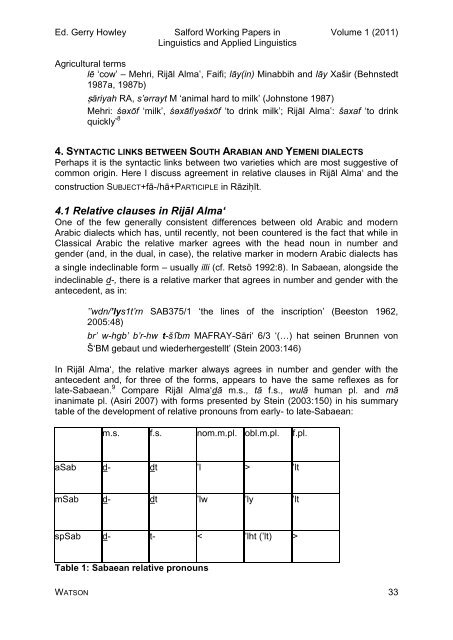South Arabian and Yemeni Dialects
South Arabian and Yemeni Dialects
South Arabian and Yemeni Dialects
Create successful ePaper yourself
Turn your PDF publications into a flip-book with our unique Google optimized e-Paper software.
Ed. Gerry Howley Salford Working Papers in<br />
Linguistics <strong>and</strong> Applied Linguistics<br />
Volume 1 (2011)<br />
Agricultural terms<br />
lē ‘cow’ – Mehri, Rijāl Alma‛, Faifi; lāy(in) Minabbih <strong>and</strong> lāy Xašir (Behnstedt<br />
1987a, 1987b)<br />
ṣāriyah RA, s’әrrayt M ‘animal hard to milk’ (Johnstone 1987)<br />
Mehri: śәxōf ‘milk’, śәxāf/yәśxōf ‘to drink milk’; Rijāl Alma‛: šaxaf ‘to drink<br />
quickly’ 8<br />
4. SYNTACTIC LINKS BETWEEN SOUTH ARABIAN AND YEMENI DIALECTS<br />
Perhaps it is the syntactic links between two varieties which are most suggestive of<br />
common origin. Here I discuss agreement in relative clauses in Rijāl Alma‘ <strong>and</strong> the<br />
construction SUBJECT+fā-/hā+PARTICIPLE in Rāziḥīt.<br />
4.1 Relative clauses in Rijāl Alma‘<br />
One of the few generally consistent differences between old Arabic <strong>and</strong> modern<br />
Arabic dialects which has, until recently, not been countered is the fact that while in<br />
Classical Arabic the relative marker agrees with the head noun in number <strong>and</strong><br />
gender (<strong>and</strong>, in the dual, in case), the relative marker in modern Arabic dialects has<br />
a single indeclinable form – usually illi (cf. Retsӧ 1992:8). In Sabaean, alongside the<br />
indeclinable d-, there is a relative marker that agrees in number <strong>and</strong> gender with the<br />
antecedent, as in:<br />
’’wdn/’lys1t’rn SAB375/1 ‘the lines of the inscription’ (Beeston 1962,<br />
2005:48)<br />
br’ w-hgb’ b’r-hw t-šʕbm MAFRAY-Sāri‘ 6/3 ‘(…) hat seinen Brunnen von<br />
Š‘BM gebaut und wiederhergestellt’ (Stein 2003:146)<br />
In Rijāl Alma‘, the relative marker always agrees in number <strong>and</strong> gender with the<br />
antecedent <strong>and</strong>, for three of the forms, appears to have the same reflexes as for<br />
late-Sabaean. 9 Compare Rijāl Alma‘dā m.s., tā f.s., wulā human pl. <strong>and</strong> mā<br />
inanimate pl. (Asiri 2007) with forms presented by Stein (2003:150) in his summary<br />
table of the development of relative pronouns from early- to late-Sabaean:<br />
m.s. f.s. nom.m.pl. obl.m.pl. f.pl.<br />
aSab d- dt ’l > ’lt<br />
mSab d- dt ’lw ’ly ’lt<br />
spSab d- t- < ’lht (’lt) ><br />
Table 1: Sabaean relative pronouns<br />
WATSON 33
















